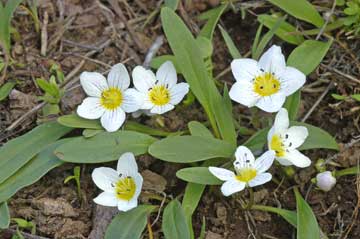 |
Dwarf hesperochiron, Hesperochiron
pumilus, (Douglas ex Griseb.) Porter
(left). The dwarf hesperochiron is a pretty little plant,
with white, loosely clustered, veined flowers. The plants bloom in the spring
on ground still moist from the snow-melt, often in the company of spring-beauties
(Claytonia spp.). Hesperochiron is derived from
hesperius (“western”), and Chiron, the name of a
mythological centaur; possibly the name was that of a similar plant in antiquity.
The species name, pumilus means “dwarf” in Latin.
Ballhead waterleaf, Hydrophyllum
capitatum Douglas ex
Benth. (right). The ballhead waterleaf is an early spring
blooming plant found along seasonal freshets or on slopes still moist from
the snowmelt. Attractive, round, frizzy, purple flowerheads up to two inches
in diameter soon appear, partially hidden by the plant's bright green, incised
leaves. The small flowers have five sepals, five petals, and five projecting
anthers. Typically purple, the flowers may range to white at subalpine
elevations. |
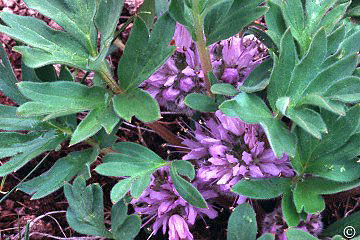 |
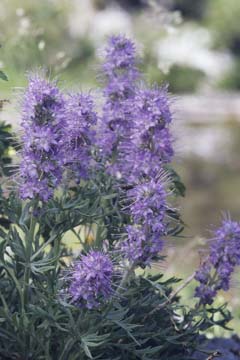 |
Phacelia is a genus made up of about
150 species, It is well represented in our mountains where several of our
phacelias are quite showy.
Purple-fringe Phacelia
sericea (Graham) A. Gray
(left, right). The purple-fringe is one of our more
spectacular alpine flowers. It blooms in early to mid-summer on the
banks of high mountain lakes and in moist open areas on ridges, where nearby
snow-banks and cornices are still melting. The species name, sericea,
means “silky” for the hairs on the foliage. Two varieties are
recognized; ours is var. sericea. A larger variety, Phacelia
sericea var. ciliosa Rydb., also grows in Idaho at lower
elevations. |
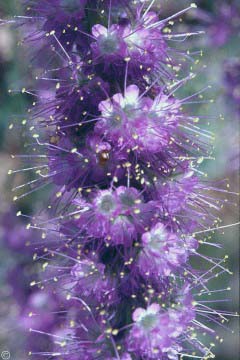 |
 |
Varied-leaf phacelia, Phacelia
heterophylla
(left). Phacelia, from the Greek phakelos, means
“bundle,” for the clustered flowers that are seen in this
genus. Varied-leaf phacelias are tall and the flowers are white-petaled (left).
A very similar plant, Phacelia
hastata Douglas ex Lehm.
with purplish flowers is shown on the right. The
species name hastata means “spear-shaped” for the plant’s
(inconstant) pointed basal leaves with small lateral lobes. Confusingly the
same leaves also occur on the varied leaf plant as shown in the image on
the left. Tightly coiled helicoid cymes are prominent in both.. Fine hairs
give these phacelias' leaves a silvery hue, more noticeably in the
hastata (right and beelow). Lewis and Clark returned with a specimen
of the Phacelia heterphylla, collected on June 7, 1806, while camped
on the Clearwater River near today's Kamiah. |
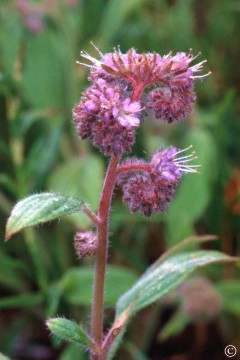 |
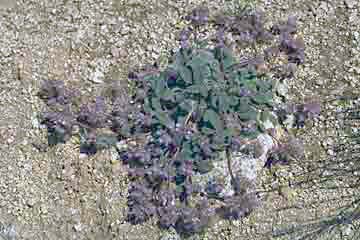 |
Silverleaf phacelia, Phacelia hastata
Douglas ex Lehm. var.
alpina
(Rydb.) Cronquist (left, right).
The alpine plant shown here is considered by some to be a form of the plant
shown above right, whereas others consider it to be a variety; or even a
separate species (Phacelia alpina (Rydb.)
Cronquist ). The alpine plants are prostrate
and their leaves are leathery, furrier, and more deeply ribbed, suggesting
that at least a varietal classification is justified.
Because of the similarity of these two phacelia species, hastata
and heterophylla, some botanists consider them varieties of a
single species.. |
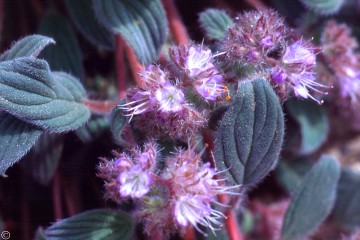 |
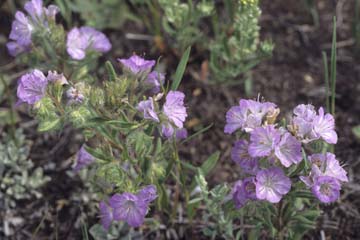 |
Thread-leaf phacelia, Phacelia
linearis (Pursh) Holz.
(left). The thread-leaf
phacelia bears showy, pink to light-purple flowers. Typically it is found
in foothills and at lower elevations in the late spring to early-summer.
It is a plant that favors dry surroundings where its narrow rather hairy
leaves conserve moisture. The leaves, while narrow, hardly seem narrow enough
to deserve the name “thread-leaf.” Meriwether Lewis collected this
plant, then new to science, on the expedition’s return trip, at
today’s The Dalles, Oregon, on April 17, 1806.
Idaho phacelia, Phacelia
idahoensis L.E. Hend. (left).
The Idaho phacelia is a tall plant whose purple flowers are borne on a spike-like
stem. As with other phacelias, the flowers are on coiled stemlets that are
responsible for an alternate common name, "scorpion-weeds" for plants in
this genus. Phacelia idahoensis grows only in the central counties
of Idaho (this plant was photographed in Custer County, west of Stanley).
The ending -ensis used with a species name has the meaning of
“originating in.” |
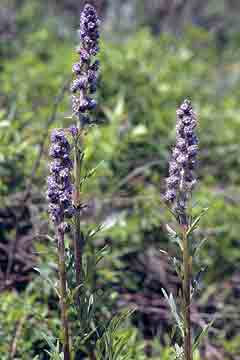 |
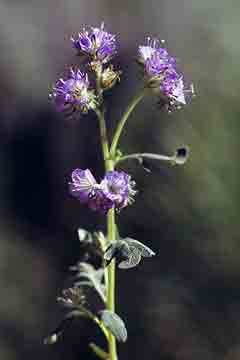 |
Franklin’s phacelia, Phacelia
franklinii (R. Br.) A. Gray
(left). The five-petaled, light purple flowers of
Franklin’s phacelia bloom in a scorpioid cyme as with many other plants
in the waterleaf family. Its leaves are pinnate with blunt lobes. The plants
may have only a single stem, but more commonly there is a central stem with
several smaller ones surrounding it to form a clump. The species namehonors
Sir John Franklin (1786-1847), an ill-fated Arctic explorer who died while
searching for a Northwest Passage. John Richardson (1787-1865), a
physician-naturalist with Franklin’s first expedition, collected this
plant in northern Saskatchewan in 1820 and named it for the expedition’s
leader. |










